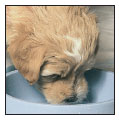Physical Characteristics of the Tibetan Terrier
(from the American Kennel Club breed standard)
Skull: Medium length neither broad nor coarse.
Head: The head is well furnished with long hair, falling forward over the eyes and foreface. The cheekbones are curved but not so overdeveloped as to bulge.
Ears: Pendant, falling not too close to the head, heavily feathered with a "V" shaped leather proportionate to the head.

Eyes: Large, set fairly wide apart, dark brown and may appear black in color, neither prominent nor sunken. Eye rims are dark in color.
Nose: Black.
Muzzle: The lower jaw has a small amount of beard. StopThere is marked stop but not exaggerated.
Teeth: White, strong and evenly placed. A tight scissors bite, a tight reverse scissors bite or a level bite are equally acceptable. A slightly undershot bite is acceptable.
Neck: Length proportionate to the body and head.
Chest: Heavily furnished.
Shoulders: Sloping, well muscled and well laid back.
Ribs: The body is well ribbed up and never cloddy or coarse.
Legs: Heavily furnished. The vertical distance from the withers to the elbow equals the distance from the elbows to the ground.
Size: Average weight is 20 to 24 pounds, but the weight range may be 18 to 30 pounds. The average height in dogs is 15 to 16 inches, bitches slightly smaller.
Body: Compact, square and strong, capable of both speed and endurance.
Topline: The back is level in motion.
Tail: Medium length, heavily furnished, set on fairly high and falls forward over the back, may curl to either side. There may be a kink near the tip.
Hindquarters:LegsWell furnished, with well bent stifles and the hind legs are slightly longer than the forelegs. ThighsRelatively broad and well muscled. HocksLow set and turn neither in nor out.
Coat: Double coat. Undercoat is soft and woolly. Outer coat is profuse and fine but never silky or woolly. May be wavy or straight. Coat is long but should not hang to the ground. A natural part is often present over the neck and back.
Color: Any color or combination of colors including white is acceptable to the breed.
Feet: Large, flat, and round in shape producing a snowshoe effect that provides traction. The pads are thick and strong. They are heavily furnished with hair between the toes and pads. The dog should stand well down on its pads.

Contents

Discover this enchanting breed from a mystical homeland and learn about the Tibetan Terrier s early ancestors, the famous Dr. Greig and other important figures in the breeds development. Follow the Tibetan Terrier to the UK and US and meet the foundation breeders and top dogs through the decades.

Lively and intelligent, with the instincts of a loyal and protective guardian, the Tibetan Terrier is a breed whose form and function are one and the same. Temperament, coat care and health considerations are discussed along with requirements for a suitable Tibetan Terrier owner.

Learn the requirements of a well-bred Tibetan Terrier by studying the description of the breed set forth in the American Kennel Club standard. Both show dogs and pets must possess key characteristics as outlined in the breed standard.

Find out about how to locate a well-bred Tibetan Terrier puppy. Discover which questions to ask the breeder and what to expect when visiting the litter. Prepare for your puppy-accessory shopping spree. Also discussed are home safety, the first trip to the vet, socialization and solving basic puppy problems.

Cover the specifics of taking care of your Tibetan Terrier every day: feeding for the puppy, adult and senior dog; grooming, including coat care, ears, eyes, nails and bathing; and exercise needs for your dog. Also discussed are ID and traveling safely with your pet.

Begin with the basics of training the puppy and adult dog. Learn the principles of house-training the Tibetan Terrier , including the use of crates and basic scent instincts. Enter puppy kindergarten and introduce the pup to his collar and leash and progress to the basic commands. Find out about obedience classes and other activities.

By Lowell Ackerman DVM, DACVD
Become your dogs healthcare advocate and a well-educated canine keeper. Select a skilled and able veterinarian. Discuss pet insurance, vaccinations and infectious diseases, the neuter/spay decision and a sensible, effective plan for parasite control, including fleas, ticks and worms.

Step into the center ring and find out about the world of showing pure-bred dogs. Heres how to get started in AKC shows, how they are organized and whats required for your dog to become a champion. Take a leap into the realms of obedience and agility tests.
K ENNEL C LUB B OOKS T IBETAN T ERRIER
ISBN: 978-1-59378-275-7
eISBN: 978-1-59378-724-0
Copyright 2006 Kennel Club Books An Imprint of I-5 Press A Division of I-5 Publishing, LLC
3 Burroughs, Irvine, CA 92618 USA
Cover Design Patented: US 6,435,559 B2 Printed in South Korea
All rights reserved. No part of this book may be reproduced in any form, by photostat, scanner, microfilm, xerography or any other means, or incorporated into any information retrieval system, electronic or mechanical, without the written permission of the copyright owner.
10 9 8 7 6 5 4 3 2 1
Photography by Carol Ann Johnson
with additional photographs by:
John Ashbey, Mary Bloom, K. Booth, Paulette Braun, Berndt Brinkmann, Cook Studio, Juliette Cunliffe, Tara Darling, Isabelle Franais, Leash to Lens Photo by Gilbert and Bill Jonas.
Illustrations by Patricia Peters.
The publisher wishes to thank all of the owners whose dogs are illustrated in this book, including Jackie Carrington, Juliette Cunliffe, Carol Ann Johnson, Cheryl and Dave Johnston, Anne Keleman, Dr. Mike Tempest and Tyras.

Next page























